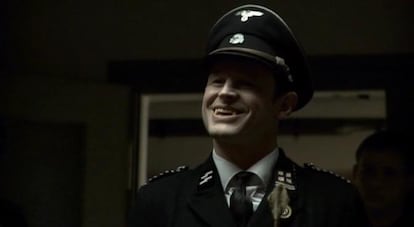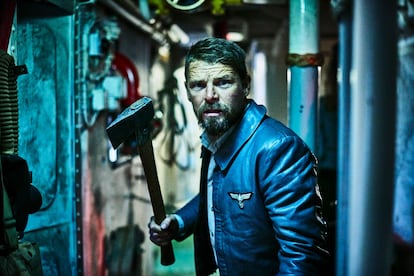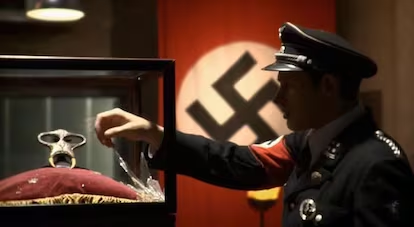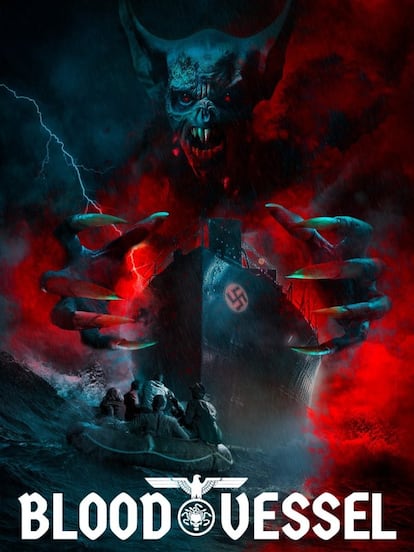Vampires, Nazis and Nazi vampires
The legendary undead have blended into the Third Reich in popular fiction. But reading the memoirs of a Waffen-SS member from Transylvania sheds light on very real evil

Returning from the Bram Stoker Festival in Dublin, dedicated to the creator of Dracula and where I have made very interesting friendships, ones that will last a lifetime and beyond, I find myself in Barcelona attending the lively fantasy festival 42, where the keynote speaker is David J. Skal, coincidentally the author of one of the most radical and sharp (like a stake) biographies of Stoker. Meanwhile, I’ve also gotten hooked on an old (meaning from 2016) vampire series on Netflix, Van Helsing, by the playwright and filmmaker Neil LaBute (five seasons), which revolves around a descendant of the professor ( Vanessa!) struggling in a post-apocalyptic world filled with bloodsuckers. In short, I can feel the vampire’s wings fluttering on the back of my neck. Simultaneously, I have also read the memoirs of a member of the Waffen-SS who was originally from Transylvania — a very real and evil character — all of which has led me to reflect on the Nazi-vampire connection, which has given rise to some curious manifestations of popular culture.
In the turbulent history of the Third Reich’s relationship with occultism and the supernatural (as if Nazism were not already sinister enough in itself) there are odd chapters, such as Himmler’s obsession with magical objects (the Holy Grail, the Holy Lance, Thor’s Hammer), and with witches (the head of the SS set up a Special Mission on Witches, the Hexen-Sonderauftrag, to study them, and this is not a joke), not to mention how much the Nazis liked the myth of the werewolf (Werwolf) towards the end of the regime. In the enemy camp, this propensity of the Nazis towards the strange provoked a reaction in certain British esoteric circles that sponsored a “magical war” against the Nazis (in terms of the secret war, the work of the commandos, the SAS and the SOE, the special operations organization dedicated to “set Europe ablaze” as per Churchill’s plan, must have surely been more useful). Meanwhile, a Spanish publishing house has just released a translation of The Magical Battle of Britain, by the occultist Dion Fortune, who was born Violet Mary Firth (1890-1946), and who headed another war in the shadows that tried to combat the Nazis and their dark panoply with their own same weapons. Fortune’s secret society, the Fraternity of the Inner Light, launched a veritable campaign of magic to counter the supposed diabolical occult powers of the Reich (the “we shall fight on the beaches, we shall fight on the landing grounds, we shall fight in the fields and in the streets, we shall fight in the hills” with the addition of “we shall fight with telepathy, meditation, spiritualism and spells). In fact, Fortune took credit for winning the Battle of Britain.

The whole thing, explains David Bizarro in his long foreword to the Spanish version of the book (100 pages out of a total of 200) has something of Bedknobs and Broomsticks about it, but we can only feel sympathy for attempt to defeat the Nazi black magic with symbols and powers of good-natured magic. It should be noted that Dion Fortune had a gift for writing: “Let us visualize Germany as a vast marsh of human helplessness and ignorance covered by the thick black cloud of ancient evil.”
Going back to the Nazi vampires, we must remember that despite their relative popularity in modern times, in literary fiction, cinema and comics (Requiem: Vampire Knight, by Mills and Ledroit, West Wind Comics , about a German soldier who dies on the Eastern Front and is turned into a vampire for his sins), in reality the Nazis did not identify with vampires but attributed that role instead to Jews. In Mein Kampf and in his speeches, Hitler attributed to the Hebrews the status of bloodsuckers and parasites of Aryan humanity. In fact, with the war of extermination that he declared on the world’s Jews, that obsession of his, he treated Jews of all ages and conditions as a plague to be eradicated by all means, employing a genocidal and ruthless method—with the idea that the survival of his own race was at stake—not unlike that unleashed on a small scale by Dr. Van Helsing and his companions in Dracula, a pattern that is common in vampire stories and that only changes in a few heterodox creations such as I am Legend, Let The Right One In or Interview with the vampire, to name a few. On the other hand, the Nazi cosmology’s obsession with blood (and the black uniforms, as well as the ferocity and the darkness of the SS) brings them closer to the Count and his army...

Among the Nazi vampires of contemporary fiction we must highlight Lord Constanta from Operation Vampyr (the first novel in a very interesting series) by David Bishop. Published in 2009, the story focuses on a young German soldier who, during the war against the USSR, comes into contact with an allied Romanian company commanded by a mysterious aristocrat and who fights only at night. Of course, he discovers that this is a unit of vampires waging war with their own evil plans. Another notable Nazi vampire is Otto Von Grimm, the character of the low-budget and highly popular film The Golden Nazi Vampyr of Absam: The secret of Kottlitz Castle, which has elements of the video game Wolfenstein (and which was renamed to be sold on DVD as Iron Nazi Vampire, to link it to the notable Nazis on the Moon franchise Iron Sky) . In the film, which has touches of dark comedy, American military intelligence assigns an occultism specialist, William BJ Blazkowicz (inspired by the star of the video games) to infiltrate the Nazis’ alpine fortress in Absam, Austria. There, SS General Von Grimm is creating an army of Nazi vampires from the remains of Count Dracula found in Wallachia by the Ahnenerbe, the SS organization for Ancestral Heritage. Just for that story alone the film should deserve an Oscar. The undercover agent believes he has destroyed the threat, but Von Grimm, who has vampirized himself with a Dracula fang, discovers that if he bathes himself in gold (like the girl from Goldfinger) he will not be affected by sunlight and can carry on with his grand plans for world domination. Another film with Nazis and vampires is the terrifying Blood Vessel (2019), where the survivors of an Allied ship torpedoed by a submarine climb aboard a Nazi minesweeper that has a coffin on board containing a strigoi, a vampire...

Of course, this quick review of Nazi vampires cannot overlook Deacon Brücke (Jonathan Brugh), one of the three main characters in What We Do in the Shadows, an essential film (presented as a mockumentary) about vampires who share an apartment in Wellington, New Zealand, and which gave rise to the series of the same title. Brücke has a past as a soldier recruited by Hitler for his Nazi vampire army. Explaining his experience to the camera, the guy, who feels the need to note that the Germans lost the war, utters an unforgettable phrase: “If you were a Nazi after the war... (dejected expression) and if you were a vampire... (dejected expression) and if you were a Nazi vampire... (waves hand with dejected expression) No way.”
And now for a real Nazi vampire. These days I have been reading Goodbye Transylvania, by Sigmund Heinz Landau, the memoirs of a Waffen-SS soldier from Romania. Here we are no longer in the realm of legend but before a chilling reality, the war waged by a young man from the German ethnic minority of the Saxons in Romania who enrolled as a volunteer in the fearsome combat units of the SS. If there was ever anything resembling a real vampire (apart from Hitler, who was quite a night owl) it is this Transylvanian of Nazi ideology involved in the bloodbath of the Eastern Front during World War II. Landau, who, like Dracula, settled in England after the war (after being investigated and denazified as much as possible), fought almost continuously for six years, most of the time against the Soviets. In his memoirs he tries to pass himself off as a pleasant and sensitive young man, but the portrait he paints of himself is abominable.

He shows a visceral hatred towards Romanians, from whom he distances himself, considering only those of German origin like him and the Hungarians as the true inhabitants of Transylvania. He describes the Romanians with despicable racism, as being dark, mixed with gypsies and with a cowardly and treacherous character; He also points out their lack of hygiene and—curiously—their smell of garlic, which disgusts him. Landau (1920-1998) explains his paramilitary training as a young man within the Germanic youth organizations in his native Brasov (he prefers to call the city Kronstadt) and how he evades conscription into the Romanian army by joining units of the Wehrmacht stationed in Romania and then, when ethnic Germans were deemed eligible for the Waffen-SS, enlisted in them. After a period of rigorous training (one exercise involves standing on a helmet while exploding a hand grenade underneath), the young man is sent into combat as a MG-34 machine gunner, passing through Polish Galicia and Ukraine and he is deployed in the Leningrad area. Landau fights hand to hand against the Soviets, participates in actions against the partisans and sees some Jews, about whom he does not give more details.
He is wounded several times, decorated, given a skull ring signed by Himmler, incorporated into a secret intelligence service attached to the Gestapo, and transferred to one of the elite divisions of the Waffen-SS, the 5th. Panzer Wiking division, which attracts the best from each house, especially the Scandinavian SS. All this supposedly without ceasing to be a good boy very much in love with his girlfriend Mitzi and longing for home. The Russians, whom he considers vicious, nauseating and inhuman, he also finds revolting. He recounts episodes of fighting that would make Sven Hassel’s hair turn gray, with a profusion of gore scenes: enemy tanks dragging pieces of human flesh and hair in their chains, the bath of blood and viscera defending positions in the steppe, a soldier looking for the hand he has lost on the battlefield. He talks about the cruelties of the Soviets and the pride he feels in seeing Hans Rudel, the ace of the Stukas (and a notable Nazi), fly by with his squadrons.
Becoming an official at the head of a tank destroyer section, the Transylvanian participates in the defense of Budapest and ends the war defending Berlin against the “subhumans and rapists” of the Red Army, and describing even more atrocious episodes (always perpetrated by others). When he is taken prisoner, he is beaten and urinated on by a female Soviet soldier. In his memoirs, written much later, there is not a hint of compassion or regret (the SS did not encourage empathy). Landau kept his ideas and hatred well entrenched until the end. One imagines him sleeping in his memories like the Count in his black Transylvanian sand.
It was very hard and bitter reading. Of course, it would have been better to re-read Dracula. But it is always good to remember where the real horror lies.
Sign up for our weekly newsletter to get more English-language news coverage from EL PAÍS USA Edition
Tu suscripción se está usando en otro dispositivo
¿Quieres añadir otro usuario a tu suscripción?
Si continúas leyendo en este dispositivo, no se podrá leer en el otro.
FlechaTu suscripción se está usando en otro dispositivo y solo puedes acceder a EL PAÍS desde un dispositivo a la vez.
Si quieres compartir tu cuenta, cambia tu suscripción a la modalidad Premium, así podrás añadir otro usuario. Cada uno accederá con su propia cuenta de email, lo que os permitirá personalizar vuestra experiencia en EL PAÍS.
¿Tienes una suscripción de empresa? Accede aquí para contratar más cuentas.
En el caso de no saber quién está usando tu cuenta, te recomendamos cambiar tu contraseña aquí.
Si decides continuar compartiendo tu cuenta, este mensaje se mostrará en tu dispositivo y en el de la otra persona que está usando tu cuenta de forma indefinida, afectando a tu experiencia de lectura. Puedes consultar aquí los términos y condiciones de la suscripción digital.
Últimas noticias
Maps of the US attack on Venezuela: Targets, airspace and deployed fleet
Venezuelans in exile: ‘This could be the end of a very dark chapter for Venezuela, but also the beginning of a time of uncertainty’
Key points of the military attack on Venezuela: Early morning bombings and a ‘captured’ president
World reactions to the US strikes on Venezuela
Most viewed
- Alain Aspect, Nobel laureate in physics: ‘Einstein was so smart that he would have had to recognize quantum entanglement’
- David King, chemist: ‘There are scientists studying how to cool the planet; nobody should stop these experiments from happening’
- Mexico completes its trade shift with the entry into force of tariffs on China and countries without trade agreements
- Reinhard Genzel, Nobel laureate in physics: ‘One-minute videos will never give you the truth’
- Oona Chaplin: ‘I told James Cameron that I was living in a treehouse and starting a permaculture project with a friend’









































